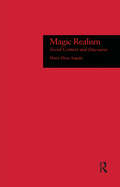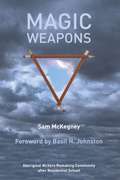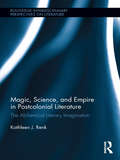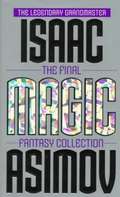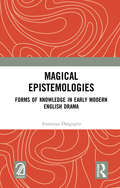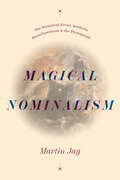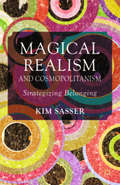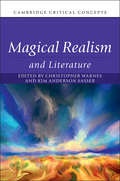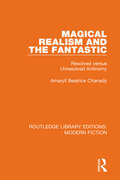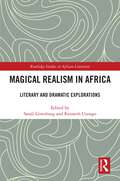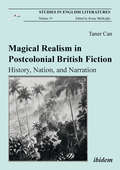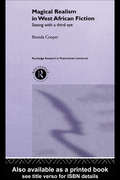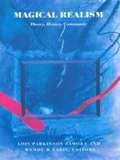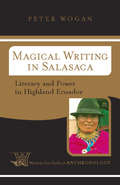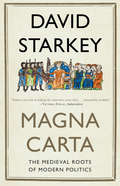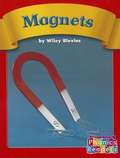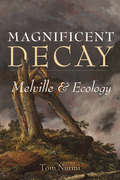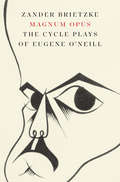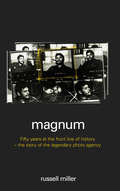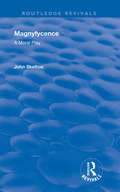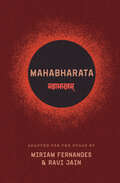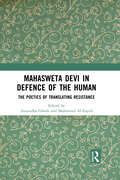- Table View
- List View
Magic Realism: Social Context and Discourse
by Maria-Elena AnguloSince the 1930s, Latin American writers have used magic realism to transcend the limits of the fantastic and illuminate social problems within the culture. The author considers five modern Latin American novels. Starting with two canonical texts of magic realism, Alejo Carpentier's El reino de este mundo (1949) and Garcia Marquez's Cien a-os de soledad (1967), the author argues that Los Sangurimas (1934), by the Ecuadorian Jos de la Cuadra, is a seminal work due to de la Cuadra's new approach to reality and his use of marvelous and hyperbolic elements. The author shows the continuation of this example in Ecuador in Demetrio Aguilera-Malta's Siete lunas y siete serpientes (1970) and Alicia Y nez Coss'o's Bruna, soroche y los tios (1972), which elucidate social problems of race, class, and gender through use of magic realism.In selecting for her study well-known writers such as Carpentier, Garcia Marquez, and others, less well-known such as de la Cuadra, Aguilera-Malta and Y nez Coss'o, the author demonstrates that both canonical and noncanonical writers for many years have been working on this new way of writing to interpret in fiction the highly complex Latin American reality.
Magic Weapons: Aboriginal Writers Remaking Community after Residential School
by Sam McKegneyThe legacy of the residential school system ripples throughout Native Canada, its fingerprints on the domestic violence, poverty, alcoholism, drug abuse, and suicide rates that continue to cripple many Native communities. Magic Weapons is the first major survey of Indigenous writings on the residential school system, and provides groundbreaking readings of life writings by Rita Joe (Mi’kmaq) and Anthony Apakark Thrasher (Inuit) as well as in-depth critical studies of better known life writings by Basil Johnston (Ojibway) and Tomson Highway (Cree). Magic Weapons examines the ways in which Indigenous survivors of residential school mobilize narrative in their struggles for personal and communal empowerment in the shadow of attempted cultural genocide. By treating Indigenous life-writings as carefully crafted aesthetic creations and interrogating their relationship to more overtly politicized historical discourses, Sam McKegney argues that Indigenous life-writings are culturally generative in ways that go beyond disclosure and recompense, re-envisioning what it means to live and write as Indigenous individuals in post-residential school Canada.
Magic, Science, and Empire in Postcolonial Literature: The Alchemical Literary Imagination (Routledge Interdisciplinary Perspectives on Literature)
by Kathleen RenkThis book examines the ways in which contemporary British and British postcolonial writers in the after-empire era draw connections between magic (defined here as Renaissance Hermetic philosophy) and science. Writers such as Tom Stoppard, Zadie Smith, and Margaret Atwood critique both imperial science, or science used in service to empire, and what Renk calls "imperical science," a distortion of rational science which denies that reality is holistic and claims that nature can and should be conquered. In warning of the dangers of imperical science, these writers restore the connection between magic and science as they examine major shifts in scientific thinking across the centuries. They reflect on the Copernican Revolution and the historic split between magic and science, scrutinize Darwinism, consider the relationship between Victorian science and pseudo-science, analyze twentieth-century Uncertainty theories, reject bio/genetic engineering, call for a new approach to science that reconnects science and art, and ultimately endeavor to bring an end to the imperial age. Overall, these writers forge a new discourse that merges science with the arts and emphasizes a holistic philosophy, a view shared by both Hermetic philosophy and recent scientific theories, such as chaos or complexity theory. Along with recent books that focus on the relationship between contemporary literature and science, this work focuses on contemporary British literature’s critique of science and the ways in which postcolonial literature addresses the relationship between magic, science, and empire.
Magic: The Final Fantasy Collection
by Isaac Asimov11 fantasy stories and also articles on various aspects of fantasy, such as writing it
Magical Epistemologies: Forms of Knowledge in Early Modern English Drama
by Anannya DasguptaThis book began with a simple question: when readers such as us encounter the term magic or figures of magicians in early modern texts, dramatic or otherwise, how do we read them? In the twenty-first century we have recourse to an array of genres and vocabulary from magical realism to fantasy fiction that does not, however, work to read a historical figure like John Dee or a fictional one he inspired in Shakespeare's Prospero. Between longings to transcend human limitation and the actual work of producing, translating, and organizing knowledge, figures such as Dee invite us to re-examine our ways of reading magic only as metaphor. If not metaphor then what else? As we parse the term magic, it reveals a rich context of use that connects various aspects of social, cultural, religious, economic, legal and medical lives of the early moderns. Magic makes its presence felt not only as a forms of knowledge but in methods of knowing in the Renaissance. The arc of dramatists and texts that this book draws between Doctor Faustus, The Tempest, The Alchemist and Comus: A Masque at Ludlow Castle offers a sustained examination of the epistemologies of magic in the context of early modern knowledge formation. Please note: Taylor & Francis does not sell or distribute the Hardback in India, Pakistan, Nepal, Bhutan, Bangladesh and Sri Lanka.
Magical Imaginations
by Genevieve GuentherIn the English Renaissance, poetry was imagined to inspire moral behaviour in its readers, but the efficacy of poetry was also linked to 'conjuration,' the theologically dangerous practice of invoking spirits with words. Magical Imaginations explores how major writers of the period ? including Spenser, Marlowe, and Shakespeare ? negotiated this troubling link between poetry and magic in their attempts to transform readers and audiences with the power of art. Through analyses of texts ranging from sermons and theological treatises to medical tracts and legal documents, Genevieve Guenther sheds new light on magic as a cultural practice in early modern England. She demonstrates that magic was a highly pragmatic, even cynical endeavor infiltrating unexpected spheres ? including Elizabethan taxation policy and Jacobean political philosophy. With this new understanding of early modern magic, and a fresh context for compelling readings of classic literary works, Magical Imaginations reveals the central importance of magic to English literary history.
Magical Nominalism: The Historical Event, Aesthetic Reenchantment, and the Photograph (The Life of Ideas)
by Martin JayA bold and wide-ranging study across centuries, examining the conflict between “conventional” and “magical” nominalism in philosophy, history, aesthetics, political theory, and photography. In this magisterial new book, intellectual historian Martin Jay traces the long-standing competition between two versions of nominalism—the “conventional” and the “magical.” Since at least William of Ockham, according to Jay, the conventional form of nominalism has contributed to the disenchantment of the world, by viewing general terms as nothing more than mere names we use to group particular objects together, rejecting the idea that they refer to a further, “higher” reality. Magical nominalism, instead, performs a reenchanting function, by investing proper names, disruptive events, and singular objects with an auratic power of their own. Drawing in part on Jewish theology, it challenges the elevation of the constitutive subject resulting from Ockham’s reliance on divine will in his critique of real universals. Starting with the fourteenth-century revolution of nominalism against Scholastic realism, Jay unpacks various “counterrevolutions” against nominalism itself, including a magical alternative to its conventional form. Focusing on fundamental debates over the relationship between language, thought, and reality, Jay illuminates connections across thinkers, disciplines, and vast realms of human experience. Ranging from theology and philosophy of history to aesthetics and political theory, this book engages with a range of artists and thinkers, including Adorno, Ankersmit, Badiou, Barthes, Bataille, Benjamin, Blumenberg, Derrida, Duchamp, Foucault, Kracauer, Kripke, and Lyotard. Ultimately, Magical Nominalism offers a strikingly original way to understand humanity’s intellectual path to modernity.
Magical Realism and Cosmopolitanism
by Kim Anderson SasserMagical Realism and Cosmopolitanism details a variety of functionalities of the mode of magical realism, focusing on its capacity to construct sociological representations of belonging. This usage is traced closely in the novels of Ben Okri, Salman Rushdie, Cristina Garc#65533;a, and Helen Oyeyemi.
Magical Realism and Literature (Cambridge Critical Concepts)
by Kim Anderson Sasser Christopher WarnesMagical realism can lay claim to being one of most recognizable genres of prose writing. It mingles the probable and improbable, the real and the fantastic, and it provided the late-twentieth century novel with an infusion of creative energy in Latin America, Africa, Asia, and beyond. Writers such as Alejo Carpentier, Gabriel García Márquez, Isabel Allende, Salman Rushdie, Ben Okri, and many others harnessed the resources of narrative realism to the representation of folklore, belief, and fantasy. This book sheds new light on magical realism, exploring in detail its global origins and development. It offers new perspectives of the history of the ideas behind this literary tradition, including magic, realism, otherness, primitivism, ethnography, indigeneity, and space and time.
Magical Realism and the Fantastic: Resolved versus Unresolved Antinomy (Routledge Library Editions: Modern Fiction #5)
by Amaryll Beatrice ChanadyEvery reader of literature interprets the literary text on the basis of information they have acquired from previous reading, and according to norms they have established, either consciously or not, with regard to a work of literature. In this study, originally published in 1985, the author clarifies the concepts of magical realism and the fantastic, and establishes a series of guidelines that will allow us to distinguish between the two similar yet independent modes. The reader will thus be able to identify the implicit framework upon which the author of the fantastic and of magical realism bases their text.
Magical Realism in Africa: Literary and Dramatic Explorations (Routledge Studies in African Literature)
by Kenneth Usongo Sarali GintsburgMagical realism has deep roots across many African languages and regions. This book explores African magical realism from a transregional and inclusive approach, drawing on contributions from different literary genres across the continent.The chapters in this book constitute a sustained and insightful reflection on the salient components of this literary genre as well as evaluating its connections to themes of conflict, violence, women’s rights, trauma, oppression, culture, governance, and connecting to the African self. As well as theorizing magical realism, this book engages with African expressive performance across various formats, novels, plays, and films. This book investigates African magical realism from its origins up to the present day, where local oral traditions link indigenous cosmogonic stories with Western literature, as well as with the specific narrative traditions of Arabo‑Islamic literature. The rich analysis draws on works from across the continent, including Egypt, Sudan, Mauritania, Cameroon, Kenya, Tanzania, Angola, and Mozambique.This book is a timely contribution to debates within African literature, cultural anthropology, ethnography, and folklore.
Magical Realism in Postcolonial British Fiction: History, Nation, and Narration (Studies in English Literatures #19)
by Taner CanThis study delineates the cultural work of magical realism as a dominant mode in postcolonial British fiction through a detailed analysis of Salman Rushdie's Midnight's Children (1981), Shashi Tharoor's The Great Indian Novel (1989), Ben Okri's The Famished Road (1991), and Syl Cheney-Coker's The Last Harmattan of Alusine Dunbar (1990). It first traces the development of magical realism from its origins in European painting to its appropriation into literature by European and Latin American writers. It then explores contested definitions of magical realism and the critical questions surrounding them and analyzes the relationship between the paradigmatic turn in postcolonial literatures and the concomitant rise of magical realism in Third World countries.
Magical Realism in West African Fiction: Seeing With A Third Eye (Routledge Research in Postcolonial Literatures)
by Brenda CooperThis study contextualizes magical realism within current debates and theories of postcoloniality and examines the fiction of three of its West African pioneers: Syl Cheney-Coker of Sierra Leone, Ben Okri of Nigeria and Kojo Laing of Ghana. Brenda Cooper explores the distinct elements of the genre in a West African context, and in relation to: * a range of global expressions of magical realism, from the work of Gabriel Garcia Marquez to that of Salman Rushdie * wider contemporary trends in African writing, with particular attention to how the realism of authors such as Chinua Achebe and Wole Soyinka has been connected with nationalist agendas. This is a fascinating and important work for all those working on African literature, magical realism, or postcoloniality.
Magical Realism: Theory, History, Community
by Lois Parkinson Zamora Wendy B. FarisMagical realism is often regarded as a regional trend, restricted to the Latin American writers who popularized it as a literary form. In this critical anthology, the first of its kind, editors Lois Parkinson Zamora and Wendy B. Faris show magical realism to be an international movement with a wide-ranging history and a significant influence among the literatures of the world. In essays on texts by writers as diverse as Toni Morrison, Günter Grass, Salman Rushdie, Derek Walcott, Abe Kobo, Gabriel García Márquez, and many others, magical realism is examined as a worldwide phenomenon.Presenting the first English translation of Franz Roh's 1925 essay in which the term magical realism was coined, as well as Alejo Carpentier's classic 1949 essay that introduced the concept of lo real maravilloso to the Americas, this anthology begins by tracing the foundations of magical realism from its origins in the art world to its current literary contexts. It offers a broad range of critical perspectives and theoretical approaches to this movement, as well as intensive analyses of various cultural traditions and individual texts from Eastern Europe, Asia, North America, Africa, the Caribbean, and Australia, in addition to those from Latin America. In situating magical realism within the expanse of literary and cultural history, this collection describes a mode of writing that has been a catalyst in the development of new regional literatures and a revitalizing force for more established narrative traditions--writing particularly alive in postcolonial contexts and a major component of postmodernist fiction.
Magical Writing in Salasaca: Literacy and Power in Highland Ecuador
by Peter WoganExplores the connections between beliefs about writing and power in an indigenous village in highland Ecuador.
Magistracy and the Historiography of the Roman Republic
by Ayelet Haimson LushkovThe study of Roman republican magistracy has traditionally been the preserve of historians posing constitutional and prosopographical questions. As a result, one fundamental aspect of our most detailed contemporary and near-contemporary sources about magistracy has remained largely neglected: their literariness. This book takes a new approach to the representation of magistrates and shows how the rhetorical and formal features of prose texts - principally Livy's history but also works by Cicero and Sallust - shape our understanding of magistracy. Applying to the texts an expanded concept of exemplarity, Haimson Lushkov shows how a rich body of anecdotes concerning the behaviour and speech of magistrates reflects on the values and tensions that defined the republic. A variety of contexts - familial, military, and electoral, among others - flesh out the experience of being, becoming, and encountering a Roman magistrate, and the political and ethical problems highlighted and negotiated in such circumstances.
Magna Carta: The Medieval Roots Of Modern Politics
by David StarkeyIn this erudite, entertaining book, award-winning historian and television presenter David Starkey untangles historical and modern misconceptions about one of the founding documents of democracy. Along the way, he shows how the Magna Carta laid the foundation for the British constitution, influenced the American Revolution and the U.S. constitution, and continues to shape jurisprudential thinking about individual rights around the world today.In 1215, King John I of England faced a domestic crisis. He had just lost an expensive campaign to retake his ancestral lands in France, an unfortunate adventure that he had funded by heavily taxing the baronial lords of England. Sick of the unpopular king's heavy-handed rule, and unimpressed by the king's unsuccessful attempt to seize Normandy, the feudal barons united to make demands of their sovereign for certain protections. These demands, the "Articles of the Barons," were submitted to the king in rough draft after the rebels occupied three cities, most significantly London. A few years later, after being edited and amplified by the then-Archbishop of Canterbury, the Articles would come to be known as the Magna Carta. The self-interested barons couldn't have known it at the time, but those demands would one day become the bedrock of democratic political development around the globe--even though that influence was largely due to mythologizing by later scholars who warped the symbolism of the document to support their arguments in favor of the rights of all citizens.Although the Magna Carta itself made no requests on behalf of the peasantry, in its structure the outlines of modern democratic reform are plainly visible. Among other things, it demanded limits on the ability of the crown to levy taxes; protection of the rights of the church; the guarantee of swift justice; and a ban on unjust imprisonment. Those protections and guarantees were strictly intended for benefit of feudal barons, but the free citizens of today's democratic nations owe an enormous debt to this history-changing document.
Magnets
by Wiley BlevinsPhonics Readers is a recognized leader in helping you teach phonics and phonemic awareness, within the context of content-area reading. Content area focus: Magnets; Phonics Skills: final e, l-blends
Magnificent Decay: Melville and Ecology (Under the Sign of Nature)
by Tom NurmiWhat is Melville beyond the whale? Long celebrated for his stories of the sea, Melville was also fascinated by the interrelations between living species and planetary systems, a perspective informing his work in ways we now term "ecological." By reading Melville in the context of nineteenth-century science, Tom Nurmi contends that he may best be understood as a proto-ecologist who innovatively engages with the entanglement of human and nonhuman realms. Melville lived during a period in which the process of scientific specialization was well underway, while the integration of science and art was concurrently being addressed by American writers. Steeped in the work of Lyell, Darwin, and other scientific pioneers, he composed stories and verse that made the complexity of geological, botanical, and zoological networks visible to a broad spectrum of readers, ironically in the most "unscientific" forms of fiction and poetry. Set against the backdrop of Melville’s literary, philosophical, and scientific influences, Magnificent Decay focuses on four of his most neglected works— Mardi (1849), Pierre (1852), The Piazza Tales (1856), and John Marr (1888)—to demonstrate that, together, literature and science offer collective insights into the past, present, and future turbulence of the Anthropocene. Tracing the convergences of ecological and literary creativity, Melville’s lesser-read texts explore the complex interplay between inanimate matter, life, and human society across multiple scales and, in so doing, illustrate the value of literary art for representing ecological relationships.
Magnum Opus: The Cycle Plays of Eugene O'Neill
by Zander BrietzkeAn original and provocative analysis of Eugene O'Neill's unfinished cycle play project From 1935 to 1939, Eugene O&’Neill worked on a series of plays that would trace the history of an American family through several generations. He completed just two of the proposed eleven plays—A Touch of the Poet and More Stately Mansions—which Zander Brietzke argues represent the core of the entire cycle. Combining archival research, literary analysis, and theatrical imagination, Magnum Opus invites an audience to see this unusual and exciting epic as a historical drama of our time.
Magnum: Fifty Years at the Front Line of History
by Russell MillerThis book is a biography of Magnum, told largely in the words of its photographers. It offers a unique perspective on half a century of world history from an extraordinary group of men and women who were front line witnesses at virtually every major event in the last fifty years. Wars, famines, natural disasters, social, political and environmental crises - Magnum photographers were there. They have been acute observers of the human condition, photographing the richest people in the world, the poorest, the least known and the most celebrated, from Marilyn Monroe to Che Guevara, JFK to Nelson Mandela, Picasso to Krushchev. This is a multi-layered story. At one level, it tells how a small group of photographrs - among them Robert Capa, Henri Cartier-Bresson and George Rodger - came together, established and nurtured a co-operative photographic agency that has survived against all the odds to become the most famous in the world. At a secondary level, it is the richly anecdotal story of the photographers themselves, their adventures around the world and their feelings about, and reactions to, their assignments.
Magnyfycence: A Moral Play (Routledge Revivals)
by John SkeltonFirst published in 1906, this edition of Magnyfycence aimed to highlight the true significance of the play within both the canon of John Skelton’s work and English drama. Robert Lee Ramsay situates Magnyfycence as a morality play which functioned as a bridge between medieval miracle plays and the modern comedy. He demonstrates the text’s significance as the first example of a play by an English man of letters and our first example of a secular and literary rather than theological morality play. This edition features an extensive scholarly introduction exploring areas such as the staging, versification, sources and characterisation, followed by the Middle-English text itself along with glosses.
Mahabharata
by Ravi Jain Miriam FernandesA contemporary dramatic take on a 4,000-year-old Sanskrit epic that is foundational to Indian culture. Why Not Theatre’s large-scale, once-in-a-generation retelling of Mahabharata brings together a cast of performers entirely from the South Asian diaspora, blending cultures and art forms in a spectacular production at the Shaw Festival and the Barbican Theatre in London. Over two parts (Karma and Dharma) and a communal meal (Khana), this translation and adaptation of Mahabharata spans generations and takes audiences into the hearts and minds of some of the most complex and enduring characters ever created. With warring families and devious revenge plots, Mahabharata tells the story of an ancient feud with philosophical and spiritual questions that are no less urgent today. In times of division, how do we find wholeness? Are we destined to repeat the mistakes of our ancestors? And how can we build a new world when we have nearly destroyed this one? Contains the full text of the play along with materials opening up the behind-the-scenes world of the production, including interviews with the creators, background and context about the source material, production photographs, a Mahabharata family tree, and glossary."Ravi Jain and Miriam Fernandes’s contemporary take on the Mahabharata is one of the most beautiful emotional journeys I have had the privilege to witness. It is inspiring, mind broadening, and speaks to all the senses. It even brings you back to the origins of theatre itself, when people would gather in the quarries around a bonfire to tell stories. With their tasteful use of technology, dance, and opera, the 4,000-year-old Sanskrit poem comes to life and feels more universal than ever. A captivating theatre experience, from the first flame to the last pixel." – Robert Lepage"In their stunning rendition of the great Indian epic Mahabharata, Ravi Jain and Miriam Fernandes brilliantly reverse the whole concept of what Bertolt Brecht famously advised theatre directors: to make the familiar, unfamiliar. Jain and Fernandes have turned the unfamiliar into the familiar. The 4,000-year-old saga most Indians grew up with is made accessible to a contemporary audience the world over. No mean feat. ‘The play, true to its source, crosses all boundaries of culture, class, and geography. Its timeless storytelling and evocative stage design is transformed into a saga for the world, with its fundamental emotions of human nature – power, hate, jealousy, greed, and lust. To be gob-smacked by this innovation would be an understatement. Immerse yourself in this take on the Mahabharata and travel with it in time into the past, present, and future of humanity." – Deepa Mehta
Mahasweta Devi in Defence of the Human: The Poetics of Translating Resistance
by Anuradha GhoshThis book re-thinks the literary and social worlds of Mahasweta Devi, the prolific and influential writer and social activist, in connection to her praxis. It brings into focus Devi’s preoccupation with the human, nature and life, and unwritten or distorted histories that underline her poetics of translating resistance in terms of a radical alterity.The defining feature of Devi’s writings is the position she adopts in defence of the human, questioning the nature of the ‘abject’ in her discourse on the oppressed. Essays in this volume focus on her subversive retellings from the Mahabharata, the political aspects of translation/adaptation of her works in literature, cinema and visual arts and comparative readings of her works by women authors from the Global South as well as the Indian diaspora. They examine her early publications, her writings for children, and the notion of aesthet(h)ics, i.e., ethics and/in aesthetics, as a gesture to pave forward a discourse on liberation and social justice that remains a challenge for the world.The book will be of significant interest to scholars and researchers of postcolonial and decolonial studies, critical translation and adaptation studies, comparative literature, the visual arts, myth and folklore studies, gender and sexuality studies, caste and ethnicity studies, culture studies, ethics in/and aesthetics, activism studies, democratic and indigenous rights discourse, South Asian studies and Global South studies.
Mahasweta Devi: Writer, Activist, Visionary (Writer in Context)
by Radha ChakravartyMahasweta Devi occupies a singular position in the history of modern Indian literature and world literature. This book engages with Devi’s works as a writer-activist who critically explored subaltern subjectivities, the limits of history and the harsh social realities of post-independence India. The volume showcases Devi’s oeuvre and versatility through samples of her writing – in translation from the original Bengali—including Jhansir Rani, Hajar Churashir Ma, and Bayen among others. It also looks at the use of language, symbolism, mythic elements and heteroglossia in Devi’s exploration of heterogeneous themes such as exploitation, violence, women’s subjectivities, depredation of the environment and failures of the nation state. The book analyses translations and adaptations of her work, debates surrounding her activism and politics and critical reception to give readers an overview of the writer’s life, influences, achievements and legacy. It highlights the multiple concerns in her writings and argues that the aesthetic aspects of Mahasweta Devi’s work form an essential part of her politics. Part of the ‘Writer in Context’ series, this book will be useful for scholars and researchers of Indian literature, Bengali literature, English literature, postcolonial studies, cultural studies, global south studies and translation studies.
